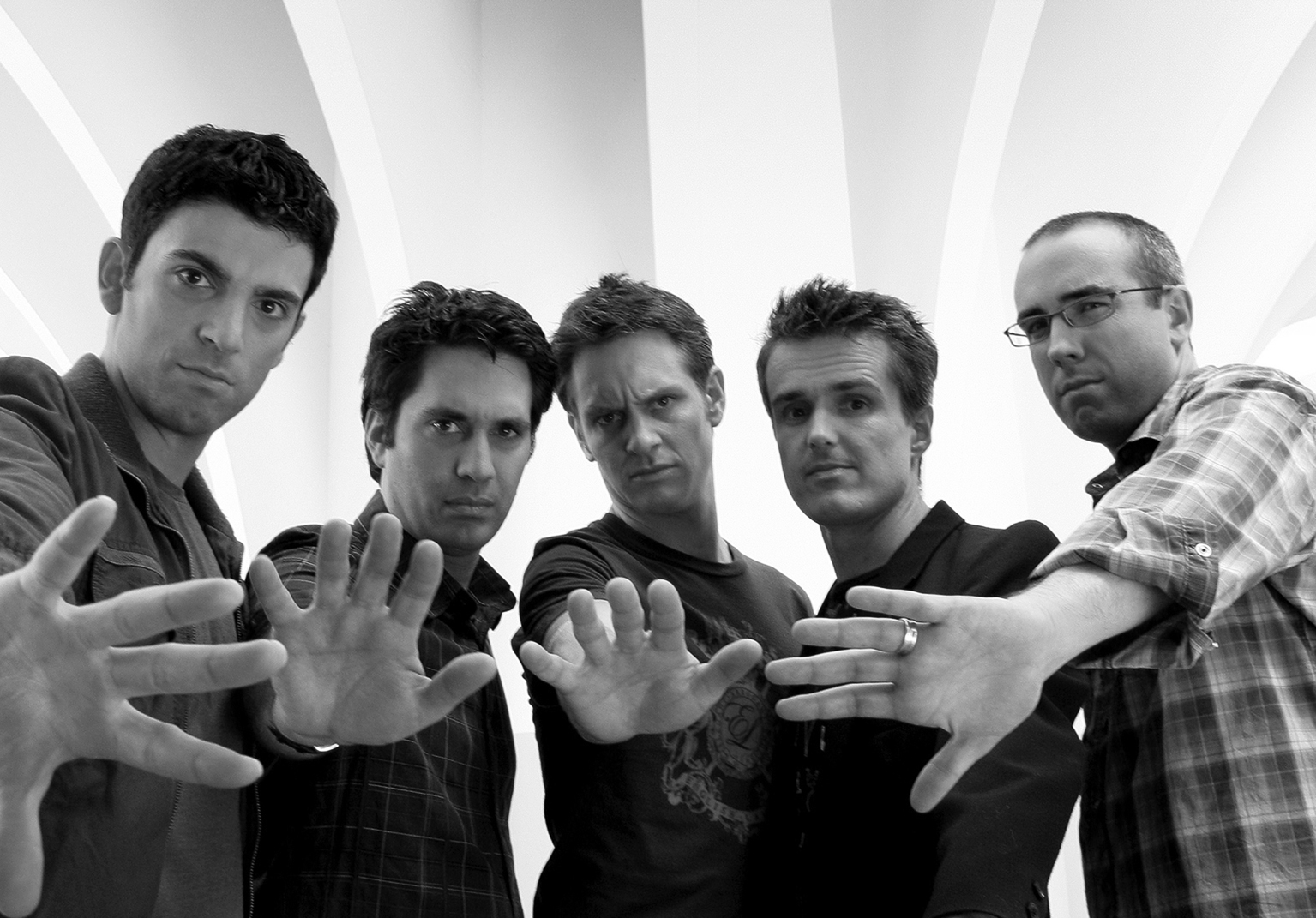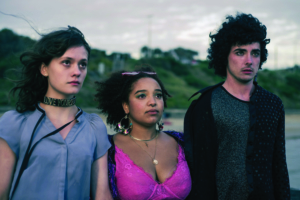If ever television needed a warning against the dangers of nostalgia, it’s now. The schedules are full of recycled programs that gasped their last some twenty years ago. For every revitalised Doctor Who – one of the few shows to have regeneration hardwired into its DNA – or Battlestar Galactica, there has been a lacklustre Bionic Woman or Knight Rider. With the possible exception of Galactica, each program has attempted to transport viewers to a cosier time in which families gathered before a single television, rather than watching different shows in every corner of the house. While networks could create new family-themed, escapist programs to drag siblings to a single couch, that would be missing the point. Newness has no connection to the past. It isn’t the programs themselves we wish to recreate, but the simpler times in which we viewed them.
In such a climate, the creaky resurrection of the Nine Network’s variety show Hey Hey It’s Saturday in September 2009 seemed inevitable. Those children of the 1980s and 1990s who once spent Saturday evenings with dinner on their laps in front of an unrealistic pink ostrich may now have children of their own, who might in turn find themselves intrigued by parental hype.
The scene is set, the dinners microwaved and our time-travelling show begins. But not everything goes to plan.
The final of two reunion shows sees visiting US singer Harry Connick Jr lecture host Daryl Somers on the racist overtones of a ‘Red Faces’ talent show segment. In the offending item, a group of men don blackface and dance absurdly in a parody of the Jackson 5. Twenty years earlier, the same performance had won the contest without so much as a head shaken. Tonight, it causes a worldwide media scandal.
It is somehow appropriate that our lust for simpler times should bring with it a clear reminder of the sort of bigotry we prefer to forget. Indeed, judging by the reaction from many within Australia, ‘simpler times’ appears to equate to an epoch of ‘simple jokes’, when casual racism was well meant and unlikely to cause offence.
This aside, the controversy following the item’s broadcast raises questions about how offence can be judged. How far can comedy push the boundaries before sparking an outrage? Are there some things that are never funny? And, crucially, does local programming now need to cater to international attitudes, given that the Internet has effectively erased broadcasting borders?
Walking the line: intent and execution
Comedy, by its nature, has always trodden a line at the edge of social niceties. The earliest jokes on record – traced back to as early as 1900 BC – are rife with sex and toilet humour. Smutty jokes trigger sniggers by highlighting the limits of community attitudes to sex, talking about the sort of things upright members of society shouldn’t talk about. Laughter here is an expression of both embarrassment and catharsis: embarrassment at being confronted by the inappropriate, relief both that something unspeakable has been said and that the joke isn’t at our expense. The recent trend for uncomfortable, often bleak or shocking comedy such as the UK’s The Office and Brass Eye and Australia’s The Chaser’s War on Everything shows that little has changed, with comedians continuing to tussle with the inappropriate in order to tell us more about ourselves. That their methods have, arguably, become more aggressive or outrageous might say more about social complacency, rather than just increasingly lax standards. Comedians are having to work harder than ever to budge us from our comfort zones. But are they going too far?
Drawing the line between satirising the inappropriate and merely being inappropriate can require an incredibly fine marker. In June 2009 the ABC’s The Chaser’s War on Everything found itself at the centre of media controversy over its ‘Make a Realistic Wish Foundation’ sketch, in which children battling cancer are urged to ‘lower their extravagance and selfishness in the face of death’. A terminally ill child who wishes to meet teen star Zac Efron is given a stick; another, who wishes to go to Disneyland, is given a pencil case. At the end, The Chaser’s Chris Taylor asks the camera: ‘Why bother, when they’re just going to die anyway?’
Whatever satirical point The Chaser might have intended was buried beneath a surge of public outrage insisting vulnerable children be forever off-limits as the perceived targets of a joke.
The media backlash was swift, particularly from more conservative elements, and the ABC suspended the show for two weeks. In the fallout, the comedians responsible apologised and the ABC’s Head of Television Comedy was demoted. Whatever satirical point The Chaser might have intended was buried beneath a surge of public outrage insisting vulnerable children be forever off-limits as the perceived targets of a joke. This was a sentiment echoed scant months later when Sydney morning radio shock-jocks Kyle Sandilands and Jackie O plunged themselves into hot water by hooking up a fourteen-year-old to a lie detector and interrogating her about her sex life. When the girl said she had been raped, Kyle proceeded to ask: ‘And is that your only experience?’ Again, the program was quickly pulled from the air and, unlike The Chaser’s War on Everything, ratings took a brief dive.[1]AAP, ‘Sandilands Back in Favour with Shock Jock Fans’, The Australian, 2 November 2009, <http://www.theaustralian.com.au/news/breaking-news/sandilands-back-in-favour-with-shock-jock-fans/story-fn3dxiwe-1225793469647>, accessed 13 November 2009.
An often hysterical media tends to treat the abuse of children in the name of entertainment as unforgivable. But there is a crucial difference between Kyle and Jackie O’s shenanigans and The Chaser’s misjudged sketch, and it is one of intent. The radio segment sought to exploit the discomfort of a vulnerable teenager, albeit with the consent of her extraordinarily unconcerned mother, while the sketch attempted to satirise society’s attempts to alleviate our guilt at inexplicable suffering. Shock value aside, The Chaser had something to say, even if they fumbled the means. At least one critic suggested that the real problem with the skit was that it simply wasn’t funny enough.[2]Ralph Horowitz, ‘The Chaser’s Only True Sin is to be Unfunny’, Crikey, 4 June 2009, <http://www.crikey.com.au/2009/06/04/the-chasers-only-true-sin-is-to-be-unfunny>, accessed 13 November 2009.
A similar furore emerged in Britain in 2001, following the broadcast of an episode of satirical current affairs program Brass
Eye. The episode in question dealt with the issue of paedophilia – surely a taboo topic for any comedian. However, the joke wasn’t at the expense of victims of sexual abuse but rather at that of the same hysterical media that denounced the program’s broadcast. At the time, Britain was in the grip of a moral panic that saw tabloid newspapers engage in a ‘name and shame’ campaign resulting in, among other things, an innocent paediatrician having her house daubed with the word ‘Paedo’ in bright yellow paint.[3]‘Paediatrician Attacks “Ignorant” Vandals’, BBC News, 30 August 2000, <http://news.bbc.co.uk/2/hi/uk_news/wales/901723.stm>, accessed 11 November 2009. It was this panic, and the inability of the media to engage rationally with a taboo topic, that writer and star Chris Morris sought to ridicule. Segments in which celebrities were asked to record messages on behalf of spoof charity ‘Nonce Sense’ and denounce the use of HOECS (pronounced ‘hoax’) – computer games supposedly used by paedophiles to seduce unsuspecting kiddies – were particularly controversial. One celebrity endorsed the statement that it was ‘scientifically proven’ that paedophiles share more genes with crabs than with other human beings, even though, as he admitted, there was ‘absolutely no evidence’. Later, Chris Morris confronted a member of militant paedophile group ‘MILIT-Pede’ and challenged him to have sex with Morris’ young son. The militant refused, explaining he didn’t fancy Morris’ son.
Over 2000 complaints were received about the program, although it went on to win a Broadcast Magazine award and became a best-seller on DVD.[4]Lucy Ward, ‘TV Spoof to Bring Tougher Regulation’, The Guardian, 30 July 2001, <http://www.guardian.co.uk/media/2001/jul/30/broadcasting.politics>, accessed 11 November 2009. The tabloids predictably denounced the show as ‘unspeakably sick’ and ‘the sickest TV show ever’. Even fans of Morris said he’d ‘gone too far’, that he’d crossed the aforementioned line that should never be crossed, however funny the joke. But Morris had achieved what he had set out to do, secondary to making people laugh, which was to create a debate and challenge notions that there are aspects of society that simply can’t be talked about.[5]Euan Ferguson, ‘Why Chris Morris had to Make Brass Eye’, The Observer, 5 August 2001, <http://www.guardian.co.uk/uk/2001/aug/05/news.film>, accessed 11 November 2009. In this, he echoed the same purpose as the ancient smutty joke – he embarrassed us (almost unbearably), said things we may have thought ourselves, and then made us relieved we weren’t in the firing line.
In its way, the controversy following Hey Hey’s ‘Jackson Jive’ segment achieved a similar sense of embarrassed self-awareness and subsequent debate. However, it was intended as empty, if cheeky, entertainment, only inadvertently exposing outdated racial attitudes. The dialogue it engendered was one that many of us seemed surprised to be having almost a decade into the twenty-first century.
Racial taboos: Hey Hey and John Safran
Like sick or vulnerable children, race is seen as a taboo target for modern comedians. Some African American comics might evoke and invert racial stereotyping in the course of their acts (in much the same way that the N-word was reclaimed as a badge of pride), but white comedians attempting racist gags will find it hard to avoid censure, as Seinfeld star Michael Richards found out in 2006.[6]‘Richards “Deeply, Deeply Sorry” for Racial Slurs’, CBC News, 20 November 2006, <http://www.cbc.ca/arts/tv/story/2006/11/20/kramer-racial-slurs.html>, accessed 11 November 2009. Still, comedy has shown it is possible to deal with taboos in a way that other genres and art forms cannot. After all, despite the controversy, Brass Eye was a success artistically, commercially and in terms of generating the discussion it craved. While comedians or entertainers may rely on such shock value as a means of attracting attention or winning a cheap laugh, shock can be a means in itself, challenging social ideas and dispelling complacency. Throughout the 1980s, a new wave of post-punk, politically driven comedians such as Ben Elton sought to do just that, using comedy as a real means of change, culminating in Comic Relief, a charity concert intended to raise awareness of and funds for Ethiopian famine relief efforts.
Yet, while comedy should, at times, make its audience uncomfortable, the ‘Red Faces’ skit made people uncomfortable for the wrong reasons. There was little evidence that the participants were seeking to deride or mock stereotypes, rather than perpetuate them. Again, the key to discriminating between racial satire and this (arguably) inadvertent racism is the question of intent, specifically the levels of irony.
In terms of irony, one of the most notable comedic uses of blackface in recent years is Papa Lazarou (Reece Shearsmith), one of the most disturbing creations in the BBC’s comedy series The League of Gentlemen. A ringmaster whose blackface seems to have become a permanent fixture (in a later show, he disguises himself by applying ‘whiteface’), this ghoulish character travels from town to town and quite literally steals the white wives of decent townsfolk. As such, he evokes inherent fears and prejudices regarding both black men and Gypsies. His blackface is not a racial mockery but a mockery of racists, reminding us of a time where it was acceptable to demean black men as daft singing and dancing clowns in order to submerge some base, primal terror.
As viewers on the cusp of a new century, we know blackface is ‘wrong’, which signals that we should be just as ill at ease with everything else Lazarou represents. He is a literal embodiment of lingering nightmares of corruption by the foreign, the Other. This is made plain in the Christmas special, when a woman, forever haunted by a vision of Father Christmas kidnapping her mother, discovers – to her peril – that it is Lazarou inside the red suit. In that moment, all her nightmares come true, the civilised comforts of Christmas forever shattered.
Following the ‘Red Faces’ controversy, concerns were raised in early October regarding a forthcoming episode of the ABC TV series John Safran’s Race Relations, which featured Safran disguising himself as an African American in order to experience the prejudice and oppression of life as a black man in modern-day America. It was expected in some quarters that this would spark a Hey Hey-style outrage,[7]Colin Vickery, ‘John Safran Disguises Himself as a Black Man for Second Episode of New ABC TV Show Race
Relations’, Herald Sun, 8 October 2009, <http://www.heraldsun.com.au/entertainment/tv/john-safran-disguises-himself-as-a-black-man-for-second-episode-of-new-abc-tv-show-race-relations/story-e6frf9ho-1225784316225>, accessed 11 November 2009. which failed to eventuate. Of far more concern, it seemed, were scenes in the first episode that saw Safran steal and sniff the underwear of Eurasian and Jewish women before masturbating over a picture of Barack Obama.
As with these high jinks, Safran disguising himself as a black man is designed to shock on two fronts. Firstly, as headline-grabbing entertainment and, secondly, as an attempt to challenge social attitudes to racial groups. The experiment is, arguably, more successful on the first front than the second.
Arriving in post-Obama America, Safran finds few African Americans seem ready, or need, to talk about their marginalisation. His questions regarding persecution seem, to his interviewees, largely outdated. Understandable perhaps, since the inspiration for his escapade is John Howard Griffin’s 1961 book Black Like Me. Griffin, a white journalist, spent six weeks travelling through segregated American states disguised as a black man. His subsequent revelations of widespread racism led to his being burned in effigy across his home state of Texas, although he claims that only nine of the 6000 letters he received were abusive.[8]John Howard Griffin, Black Like Me: 35th Anniversary Edition, Signet, 1996, p.160.
Safran’s experiences are nowhere near as revealing. Despite his attempts to track down examples of racism, the only examples of prejudice we see are largely the result of him picking a fight with white customers of a late-night burger joint.
Nonetheless, as with The Chaser’s skit, Safran’s motives are understandable, even if the execution is lacking. While Safran’s other series (John Safran’s Music Jamboree; John Safran vs God) have had a clearly stated intent, his attempts to tangle with the race issue seem strangely unfocused, as if he is caught between seeking to embarrass and seeking to meaningfully engage. He may ultimately be disappointed that he has failed to cause the controversy he seems to crave, and fair enough. Perhaps the reason for the lack of controversy is that, while his knicker-sniffing shenanigans might embarrass, he has failed to hit the taboo nerve sprung intentionally by Lazarou and accidentally by the ‘Jackson Jive’.
The world is watching: social values and global audiences
Another possibility, one raised by an increasingly reactionary media in the wake of the Hey Hey outrage, is that Australia doesn’t share the same uncomfortable racial attitudes as the rest of the planet. After all, it was American Connick Jr who caused a fuss – fellow judge Jackie McDonald was quite happy to award the blackface act eight out of ten. Given that Australia doesn’t have a history of African slavery, was it possible that we could employ the blackface conventions innocently and inoffensively?
Most respondents to a news.com.au poll seemed to think so – sixty-nine per cent, to be exact.[9]‘Readers Says [sic] Hey Hey’s Jackson Jive skit “Not Racist”’, news.com.au, 8 October 2009, <http://www.news.com.au/entertainment/story/0,28383,26182943-10229,00.html>, accessed 11 November 2009. Just over a week later, Melbourne’s Herald Sun newspaper ran a piece about the run-on effects for purveyors of blackface golliwog toys, accompanied by a photograph of a mournful white toddler saying goodbye to her ‘racist’ toys. There was even an attempt to justify children playing with such ‘darkie’ iconography on the grounds it ‘promotes racial harmony’.[10]Kelly Ryan, ‘Golliwogs Banished after Hey Hey It’s Saturday Blackface Row’, Herald Sun, 16 October 2009, <http://www.news.com.au/story/0,27574,26216260-421,00.html>, accessed 11 November 2009. Such disingenuousness aside, the suggestion seems to be that increased awareness of inappropriate or offensive behaviour somehow results in a tragic loss of innocence. Which, in some ways, it does. Seen in this light, Australia being a nation proud of being young and free seems to amount to being proudly naive.
Yet a glance through the headlines should be enough to remind us that we’re not excused from the racial tensions the outside world has wrestled with for centuries. For every claim of multiculturalism, we have pictures of Indian students rioting in the streets. For every happy migrant, we have dozens of wannabe migrants trapped on a boat in the Indian Ocean. We are a nation who only last year apologised for the racist treatment of our Indigenous population, as an opening gesture of reconciliation. Nor was the ‘Jackson Jive’ an isolated incident, as those who remember Sam Newman’s Nicky Winmar impersonation on The Footy Show in 1998 can attest.
In this context, what the reaction to the Hey Hey skit – within Australia, at least – appears to demonstrate is that we are a society still not ready to talk about these things, perhaps convinced that we don’t have to. We are not ready to be embarrassed and startled from our complacency.
It is also missing the point to suggest that the skit caused offence because what was appropriate to Australian audiences in 1989 is no longer appropriate – twenty years ago was still two decades after the first complaints in Britain about The Black and White Minstrel Show.[11]‘Minstrels Founder Mitchell Dies’, BBC News, 29 August 2002, <http://news.bbc.co.uk/2/hi/entertainment/2223239.stm>, accessed 13 November 2009. Tellingly, Enid Blyton’s books had already been revised to remove golliwog characters.[12]Mike Collett-White, ‘Noddy Returns, Minus Golliwogs, to Mark 60th Year’, Reuters, 29 October 2009, <http://www.reuters.com/article/mediaNews/idUSLT35409020091029>, accessed 13 November 2009. Blackface was already inappropriate. What had changed in 2009 was that this time we weren’t alone. The world was watching.
It may have taken an American to alert the Hey Hey team to the inappropriateness of the blackface skit, but it was what happened to the footage next that exposes the workings of a modern media outrage.
Delivering the 2009 Andrew Olle Media Lecture some months after his show’s suspension, Chaser cast member and executive producer Julian Morrow identified two waves of viewers, primary and secondary, enabled by a collision between terrestrial broadcast and online video sharing. The primary viewers are those sitting in front of the television, watching a program because they want to watch it; the secondary viewers are those who later seek out excerpts from the program precisely because they are controversial.[13]Julian Morrow, ‘2009 Andrew Olle Media Lecture’, ABC Sydney, <http://www.abc.net.au/local/stories/2009/11/07/2735643.htm>, accessed 11 November 2009. The rise of social networking and the viral spreading of video clips have created a constantly hungry market for the strange, the funny, the outrageous and the just plain ‘wrong’. As such, the potential for outrage is greatly magnified, while the chattering nature of social networks means the sparks of debate can quickly become a wildfire.
Detached from its context, the most innocuous of comments can appear damning, so it is hardly surprising that edgy comedy should become the basis for hastily formed protest groups and complaint campaigns. As the online reaction intensifies, it then returns to the mainstream media, who are ever-ready to report a scandal.
In the case of the ‘Jackson Jive’, this secondary wave included viewers from parts of the world for whom the wounds of blackface were particularly raw. The timing of the segment’s broadcast meant that by the time the first clips were appearing on YouTube, the rest of the Western world was logging on for the day. International reaction was swift and, largely, damning. A Guardian blogger called the skit ‘mind-boggling’ and rather snidely thanked Australia for another contribution to ‘the annals of human culture’,[14]Marina Hyde, ‘Harry Connick Jr Weirdly Unimpressed by Australia’s Blackface Jackson 5’, The Guardian, Lost in Showbiz blog, 7 October 2009, <http://www.guardian.co.uk/lifeandstyle/lostinshowbiz/2009/oct/07/harry-connick-jr-blackface-jackson-jive>, accessed 12 November 2009. while Chicago blogger Kyla Kyles was ‘too disgusted’ by the video to comment at length. Even Fox News commentator Bill O’Reilly – never the most sensitive of characters – was bemused by the outdated antics of ‘some dopey show’.[15]‘Some Dopey Show’, <http://player.video.news.com.au/couriermail/?_nSUXXMAdZA5J3Kifd2acieDMq6JtJZ5>, accessed 12 November 2009.
In response, local media and viewers quickly adopted a defensive posture, neatly summed up by comments such as the following from a news.com.au reader, responding to attempts by a Canadian reader to explain why the skit was offensive:
[W]hilst we appreciate that you have a particular point of view in this matter, please understand that this is neither Canada nor the United States. This is Australia. Grow up and grow some skin.[16]Comment from ‘Readers Says [sic] Hey Hey’s Jackson Jive Skit “Not Racist”’, news.com.au, 8 October 2009, <http://www.news.com.au/entertainment/story/0,28383,26182943-10229,00.html>, accessed 11 November 2009.
Leaving aside the question of whether blackface actually is acceptable in Australia, a notion challenged by writers such as Kyles, the above comment ignores the secondary audience Morrow identified. Just as the ABC was unable to effectively ‘ban’ the offending Chaser skit due to its rapid appearance and dissemination on the Internet, networks are unable to confine their broadcasts to national borders. When deciding whether an item has transgressed ‘community standards’, the question has to be asked – which community? In an age of near-instantaneous file-sharing, we can no longer expect to function as a culture in isolation. Regardless of whether international viewers are simply oversensitive and uptight, they are watching, and willing to let us know when they are not amused.
Of course, a larger audience should ultimately present comedians with more opportunities than limitations, given their trade in provocation. Rather than cowering from potential offence on some far-flung shore, writers and performers can revel in the new possibilities for shaking off the blinkers of complacency on a global scale.
Indeed, perhaps comedians are now in an ideal position to test shifting levels of acceptability between nations. There are unprecedented chances for both embarrassment and catharsis. But the Hey Hey controversy should stand as a reminder that the old jokes truly aren’t the best. In a world where anyone could be listening, there’s a good chance someone out there has already heard them and doesn’t find them funny anymore.
Endnotes
| 1 | AAP, ‘Sandilands Back in Favour with Shock Jock Fans’, The Australian, 2 November 2009, <http://www.theaustralian.com.au/news/breaking-news/sandilands-back-in-favour-with-shock-jock-fans/story-fn3dxiwe-1225793469647>, accessed 13 November 2009. |
|---|---|
| 2 | Ralph Horowitz, ‘The Chaser’s Only True Sin is to be Unfunny’, Crikey, 4 June 2009, <http://www.crikey.com.au/2009/06/04/the-chasers-only-true-sin-is-to-be-unfunny>, accessed 13 November 2009. |
| 3 | ‘Paediatrician Attacks “Ignorant” Vandals’, BBC News, 30 August 2000, <http://news.bbc.co.uk/2/hi/uk_news/wales/901723.stm>, accessed 11 November 2009. |
| 4 | Lucy Ward, ‘TV Spoof to Bring Tougher Regulation’, The Guardian, 30 July 2001, <http://www.guardian.co.uk/media/2001/jul/30/broadcasting.politics>, accessed 11 November 2009. |
| 5 | Euan Ferguson, ‘Why Chris Morris had to Make Brass Eye’, The Observer, 5 August 2001, <http://www.guardian.co.uk/uk/2001/aug/05/news.film>, accessed 11 November 2009. |
| 6 | ‘Richards “Deeply, Deeply Sorry” for Racial Slurs’, CBC News, 20 November 2006, <http://www.cbc.ca/arts/tv/story/2006/11/20/kramer-racial-slurs.html>, accessed 11 November 2009. |
| 7 | Colin Vickery, ‘John Safran Disguises Himself as a Black Man for Second Episode of New ABC TV Show Race Relations’, Herald Sun, 8 October 2009, <http://www.heraldsun.com.au/entertainment/tv/john-safran-disguises-himself-as-a-black-man-for-second-episode-of-new-abc-tv-show-race-relations/story-e6frf9ho-1225784316225>, accessed 11 November 2009. |
| 8 | John Howard Griffin, Black Like Me: 35th Anniversary Edition, Signet, 1996, p.160. |
| 9 | ‘Readers Says [sic] Hey Hey’s Jackson Jive skit “Not Racist”’, news.com.au, 8 October 2009, <http://www.news.com.au/entertainment/story/0,28383,26182943-10229,00.html>, accessed 11 November 2009. |
| 10 | Kelly Ryan, ‘Golliwogs Banished after Hey Hey It’s Saturday Blackface Row’, Herald Sun, 16 October 2009, <http://www.news.com.au/story/0,27574,26216260-421,00.html>, accessed 11 November 2009. |
| 11 | ‘Minstrels Founder Mitchell Dies’, BBC News, 29 August 2002, <http://news.bbc.co.uk/2/hi/entertainment/2223239.stm>, accessed 13 November 2009. |
| 12 | Mike Collett-White, ‘Noddy Returns, Minus Golliwogs, to Mark 60th Year’, Reuters, 29 October 2009, <http://www.reuters.com/article/mediaNews/idUSLT35409020091029>, accessed 13 November 2009. |
| 13 | Julian Morrow, ‘2009 Andrew Olle Media Lecture’, ABC Sydney, <http://www.abc.net.au/local/stories/2009/11/07/2735643.htm>, accessed 11 November 2009. |
| 14 | Marina Hyde, ‘Harry Connick Jr Weirdly Unimpressed by Australia’s Blackface Jackson 5’, The Guardian, Lost in Showbiz blog, 7 October 2009, <http://www.guardian.co.uk/lifeandstyle/lostinshowbiz/2009/oct/07/harry-connick-jr-blackface-jackson-jive>, accessed 12 November 2009. |
| 15 | ‘Some Dopey Show’, <http://player.video.news.com.au/couriermail/?_nSUXXMAdZA5J3Kifd2acieDMq6JtJZ5>, accessed 12 November 2009. |
| 16 | Comment from ‘Readers Says [sic] Hey Hey’s Jackson Jive Skit “Not Racist”’, news.com.au, 8 October 2009, <http://www.news.com.au/entertainment/story/0,28383,26182943-10229,00.html>, accessed 11 November 2009. |





